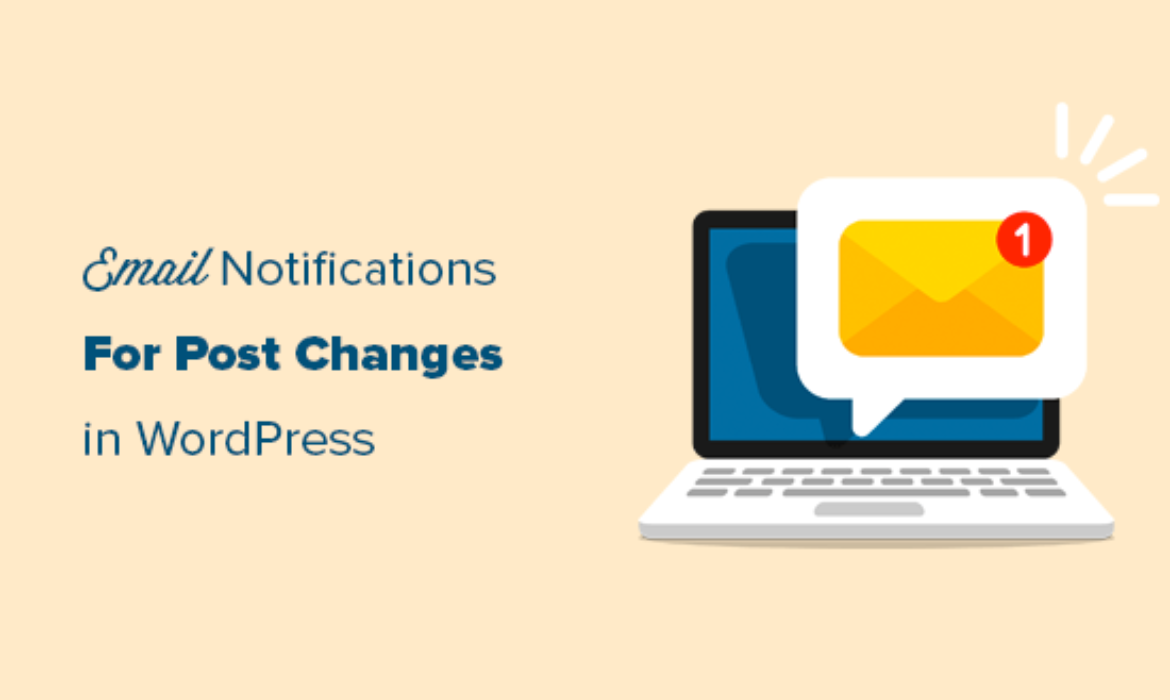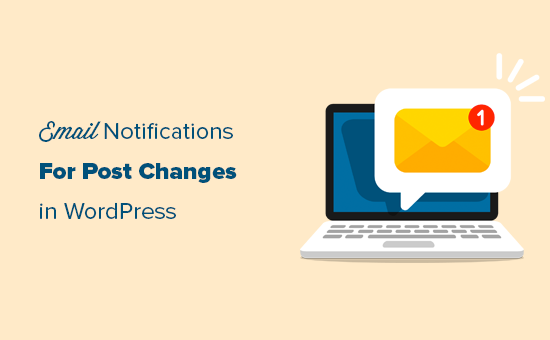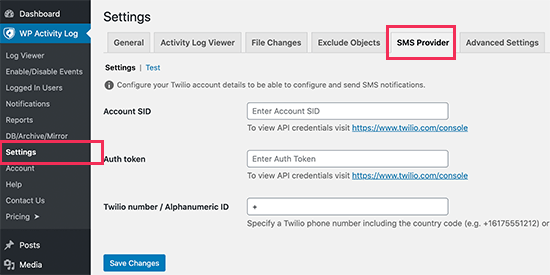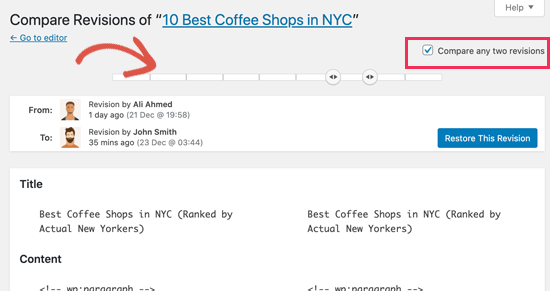
Do you want to get email notifications for post changes in WordPress?
By default, WordPress does not send any notifications when posts are changed by any user. If you run a multi-author WordPress site, then you may want to stay informed about post changes on your website.
In this article, we will show how to get email notifications for post changes in WordPress.
Why Set up Email Notifications for Post Changes in WordPress?
If you are the only one working on your own WordPress website, then it is easier to keep an eye on everything that is happening on your website.
However, if you have other authors writing blog posts, or SEO specialists optimizing blog posts for SEO, then you may want to keep an eye on the changes they make.
For instance, you may want to be alerted when a new post is published or if changes were made to an older article.
This also helps all team members accountable. If they make a mistake, then it can be easily caught and remedied quickly.
That being said, let’s take a look at how to easily set up email notifications for post changes in WordPress.
We’ll be showing you two methods to do that, you can choose one that works best for you. We’ll also show you how to undo changes and improve the deliverability of WordPress notification emails.
- Set up email notifications for post changes using WP Activity Log
- Set up email notifications for post changes using Better Notifications for WP
- Revise and undo post changes in WordPress
- Troubleshoot email notification issues in WordPress
Method 1. Set up Post Changes Notifications in WordPress using WP Activity Log
This method is recommended for all users as it is easier, powerful, and flexible.
First thing you need to do is install and activate the WP Activity Log plugin. For more details, see our step by step guide on how to install a WordPress plugin.
Upon activation, you’ll be asked to enter your license key. You can find this information under your account on the WP Activity Log website.
Next, you’ll be given the option to run the set up wizard . You can answer a few quick questions to set up important monitoring and logging features. All these things can be changed later in plugin settings too.
After that, you need to visit WP Activity Log » Notifications page and switch to the Content Changes tab.
From here, you need to select the events that will trigger notifications. The plugin comes with three default notifications covering most content changes.
Next to each event, you need to enter the email address you want to send notifications to. Optionally, you can also add a mobile phone number to get SMS notifications for post changes (we will show you how to set it up later in this article).
Finally, click on the Save notifications button to store your changes.
Setting up SMS Notifications for Post Changes in WordPress
WP Activity Log allows you to easily receive SMS notifications for post changes and other WordPress activities. To do that, you’ll need a Twilio account and a phone number.
Twillio is a paid service with a pay as you go pricing model for SMS starting at $0.0075 per SMS. You’ll also need to purchase a virtual phone number which will be used to send messages.
Simply go to the Twillio website and signup for a free trial account.
After setting up your account, you’ll reach the Twillio dashboard where you can copy your Account SID, Auth Token, and get a trial phone number.
Copy and paste these values to a text editor or leave this browser tab open.
Next, switch back to your WordPress website admin area and visit the WP Activitiy Log » Settings page. From here, switch to the SMS Provider tab and enter your Twilio credentials.
Don’t forget to click on the save changes button to store your settings.
Testing Your Post Changes Notifications with WP Activity Log
WP Activity Log allows you to easily test your post change notifications. Simply go back to the WP Activity Log » Notifications page and switch to the ‘Content Changes’ tab.
Scroll down and click on the ‘Test Notifications’ button. This will bring up a popup window where you can enter an email address and a mobile phone number to send notifications.
WP Activity Log will then send test notifications. If you do not receive an email notification right away, then you can jump to the fixing email notifications in the WordPress section.
If you fail to receive SMS notifications, then check your Twilio credentials to make sure they are correct.
Method 2. Sending Email Notifications for Post Changes with Better WordPress Notifications
This method is easy to use, but it doesn’t come with ready-made template. While this method allows you to send an email notification when a post is changed, you would have to write the email yourself and investigate the activity on your own.
First, you need to install and activate the Better Notifications for WordPress plugin. For more details, see our step by step guide on how to install a WordPress plugin.
Upon activation, you need to visit Notifications » Add New page to create your first custom notification.
First, you need to provide a title for the notification. After that, choose the ‘Notification for’ option, which is the event that will trigger this notification.
For instance, we have chosen ‘Post Updated’ as the event for this notification.
Next, you can set email options like from, cc, sender email. You can skip them and the plugin will use your default WordPress email settings.
Next, you need to select the users or user roles that will receive this notification under the ‘Send to’ option. Below that you can write the email subject and the message itself.
Better Notifications for WP doesn’t come with a template for post changes. This means you’ll need to write your own email message.
The plugin comes with a bunch of shortcodes that you can use. You can view all of them by clicking on the ‘Find shortcodes’ button.
Lastly, you need to click on the Save button to store your email notification. After that, you’ll be able to click on the ‘Send Me a Test Email’ button to see if it is working.
Better Notification for WordPress is not an activity monitoring plugin. This means you’ll need to set up multiple notifications to cover different types of content changes in WordPress.
For instance, you may want to set up a ‘Notification for’ when a new ‘Post Published’ or another one for when a category or tag is changed, and more.
It also allows you to create custom notifications or modify default WordPress notifications as well. For more details, see our article on how to create better custom notifications in WordPress.
Revise and Undo Post Changes in WordPress
Once you have received an email notification for post changes, you may want to see what changes were made, who made them, and when.
WordPress comes with a built-in revision management system that keeps track of all changes made to an article.
Simply edit the post or page that you want to review and then click on the ‘Revisions’ tab under the ‘Post’ settings from the right-column.
This will bring you to the post revisions screen where you can check the ‘Compare two revisions’ box and then move the slider below to compare the changes.
Scroll down and you will see the changes between the two revisions highlighted in red and green colors.
If you don’t like the changes, then you can simply click on the ‘Restore revision’ button to undo them and return to the previous version.
Troubleshooting Email Notifications in WordPress
By default, WordPress uses the PHP mail() function to send emails.
This method does not use proper authentication (login or password) which means it can be easily misused. This is why most spam filters mark such emails as spam or block them altogether.
To fix this, you need to use a proper SMTP service provider to send out WordPress emails. There are even free SMTP servers like Gmail, Sendinblue, Sendgrid, and more that you can use with WordPress.
To set up SMTP, you need to install and activate the WP Mail SMTP plugin. For more details, see our step by step guide on how to install a WordPress plugin.
WP Mail SMTP allows you to connect your WordPress site to your SMTP service provider and send all your WordPress emails with much higher deliverability.
Upon activation, you need to go to the WP Mail SMTP » Settings page in your WordPress admin area to set up the plugin.
First, you need to enter your license key. You can find this information under your account on the WP Mail SMTP website.
After that, scroll down to the ‘Mailer’ section to select your SMTP service provider. WP Mail SMTP will show all top SMTP service providers. You can click on your provider and then enter the required information below (usually an API key).
If your mailer is not listed, then you can simply choose ‘Other SMTP’ option and enter the required information.
For more detailed instructions, see our tutorial on how to fix WordPress not sending email issue.
We hope this article helped you set up email notifications for post changes in WordPress. You may also want to see our tips on getting more traffic to your blog and the best WordPress SEO plugins and tools to grow your website.
If you liked this article, then please subscribe to our YouTube Channel for WordPress video tutorials. You can also find us on Twitter and Facebook.
The post How to Get Email Notification for Post Changes in WordPress appeared first on WPBeginner.





















Subscribe to MarketingSolution.
Receive web development discounts & web design tutorials.
Now! Lets GROW Together!